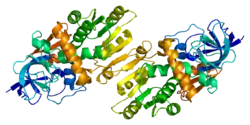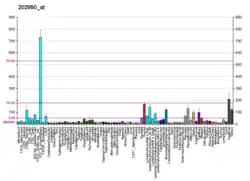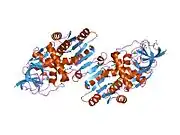CRYZ
Quinone oxidoreductase is an enzyme that in humans is encoded by the CRYZ gene.[5]
Crystallins are separated into two classes: taxon-specific, or enzyme, and ubiquitous. The latter class constitutes the major proteins of vertebrate eye lens and maintains the transparency and refractive index of the lens. The former class is also called phylogenetically-restricted crystallins. This gene encodes a taxon-specific crystallin protein which has NADPH-dependent quinone reductase activity distinct from other known quinone reductases. It lacks alcohol dehydrogenase activity although by similarity it is considered a member of the zinc-containing alcohol dehydrogenase family. Unlike other mammalian species, in humans, lens expression is low. One pseudogene is known to exist.[5]
References
- GRCh38: Ensembl release 89: ENSG00000116791 - Ensembl, May 2017
- GRCm38: Ensembl release 89: ENSMUSG00000028199 - Ensembl, May 2017
- "Human PubMed Reference:". National Center for Biotechnology Information, U.S. National Library of Medicine.
- "Mouse PubMed Reference:". National Center for Biotechnology Information, U.S. National Library of Medicine.
- "Entrez Gene: CRYZ crystallin, zeta (quinone reductase)".
External links
- Human CRYZ genome location and CRYZ gene details page in the UCSC Genome Browser.
Further reading
- Heinzmann C, Kojis TL, Gonzalez P, et al. (1995). "Assignment of the zeta-crystallin gene (CRYZ) to human chromosome 1p22-p31 and identification of restriction fragment length polymorphisms". Genomics. 23 (2): 403–7. doi:10.1006/geno.1994.1516. PMID 7835889.
- Gonzalez P, Rao PV, Zigler JS (1994). "Organization of the human zeta-crystallin/quinone reductase gene (CRYZ)". Genomics. 21 (2): 317–24. doi:10.1006/geno.1994.1272. PMID 8088825.
- Maruyama K, Sugano S (1994). "Oligo-capping: a simple method to replace the cap structure of eukaryotic mRNAs with oligoribonucleotides". Gene. 138 (1–2): 171–4. doi:10.1016/0378-1119(94)90802-8. PMID 8125298.
- Gonzalez P, Rao PV, Zigler JS (1993). "Molecular cloning and sequencing of zeta-crystallin/quinone reductase cDNA from human liver". Biochem. Biophys. Res. Commun. 191 (3): 902–7. doi:10.1006/bbrc.1993.1302. PMID 8466529.
- Suzuki Y, Yoshitomo-Nakagawa K, Maruyama K, et al. (1997). "Construction and characterization of a full length-enriched and a 5'-end-enriched cDNA library". Gene. 200 (1–2): 149–56. doi:10.1016/S0378-1119(97)00411-3. PMID 9373149.
- Wang W, Liu LQ, Higuchi CM, Chen H (1998). "Induction of NADPH:quinone reductase by dietary phytoestrogens in colonic Colo205 cells". Biochem. Pharmacol. 56 (2): 189–95. doi:10.1016/S0006-2952(98)00141-5. PMID 9698072.
- Goenka S, Raman B, Ramakrishna T, Rao CM (2001). "Unfolding and refolding of a quinone oxidoreductase: alpha-crystallin, a molecular chaperone, assists its reactivation". Biochem. J. 359 (Pt 3): 547–56. doi:10.1042/0264-6021:3590547. PMC 1222175. PMID 11672428.
- Strausberg RL, Feingold EA, Grouse LH, et al. (2003). "Generation and initial analysis of more than 15,000 full-length human and mouse cDNA sequences". Proc. Natl. Acad. Sci. U.S.A. 99 (26): 16899–903. doi:10.1073/pnas.242603899. PMC 139241. PMID 12477932.
- Bianco NR, Perry G, Smith MA, et al. (2004). "Functional implications of antiestrogen induction of quinone reductase: inhibition of estrogen-induced deoxyribonucleic acid damage". Mol. Endocrinol. 17 (7): 1344–55. doi:10.1210/me.2002-0382. PMID 12714703.
- Ota T, Suzuki Y, Nishikawa T, et al. (2004). "Complete sequencing and characterization of 21,243 full-length human cDNAs". Nat. Genet. 36 (1): 40–5. doi:10.1038/ng1285. PMID 14702039.
- Gerhard DS, Wagner L, Feingold EA, et al. (2004). "The Status, Quality, and Expansion of the NIH Full-Length cDNA Project: The Mammalian Gene Collection (MGC)". Genome Res. 14 (10B): 2121–7. doi:10.1101/gr.2596504. PMC 528928. PMID 15489334.






